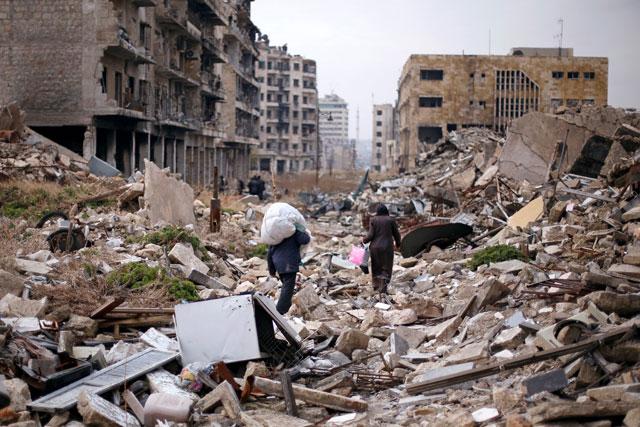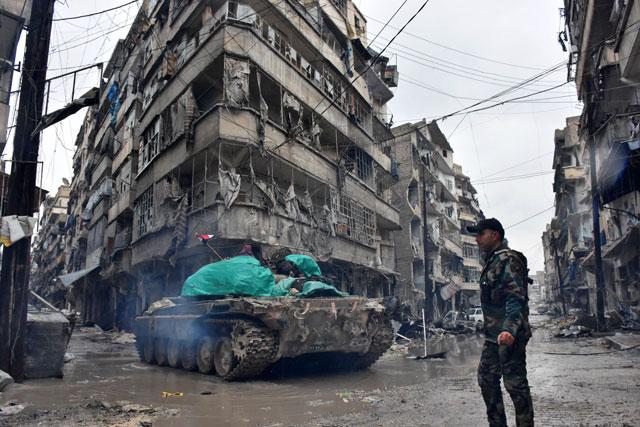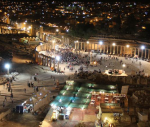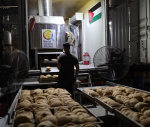You are here
Aleppo evacuation resumes after day-long hold-up
By Reuters - Dec 21,2016 - Last updated at Dec 21,2016
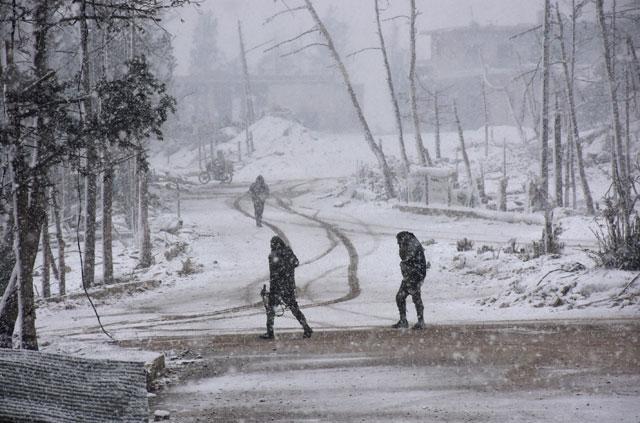
Syrian pro-government forces walk as snow falls in Aleppo on Wednesday (AFP photo)
BEIRUT — Buses carrying Syrian civilians and fighters began leaving the last rebel-held enclave of Aleppo on Wednesday after being stalled for a day, aid officials and pro-government media reports said.
Obstacles hindering evacuations from East Aleppo and from two villages besieged by rebels outside the city had been overcome and the operation would be completed within hours, according to a news service run by the Lebanese group Hizbollah, an ally of the Syrian government.
The eventual departure of the thousands left in the insurgent zone will hand full control of the city to President Bashar Assad, the biggest prize of Syria's nearly six-year-old civil war.
"Buses are now moving again from East Aleppo. We hope that this continues so that people can be safely evacuated," a UN official in Syria told Reuters, as snow began to fall on Aleppo.
People had been waiting in freezing temperatures since the evacuation hit problems on Tuesday, when dozens of buses were stuck in Aleppo and the evacuation of the two Shiite villages, Al Foua and Kefraya, also stalled. Rebels and government forces blamed each other for the hold-up.
Charity Save the Children said heavy snows were hampering aid efforts.
"Our partners are trying to treat injured children who have fled Aleppo but the situation is dire. Many had to have limbs amputated because they did not receive care on time, and far too many are weak and malnourished," a statement said.
One 5-month-old girl had two broken legs, a broken arm and an open wound in her stomach, the statement said.
Many of those who had escaped Aleppo were sleeping in unheated buildings or tents in sub-zero temperatures. Children have been separated from their parents in the chaos as they run to get food when they get off the buses, the charity said.
Evacuation plan
With obstructions to the evacuation plan apparently overcome, the Hizbollah news service said 20 buses carrying fighters and their families had moved from east Aleppo on Wednesday towards rebel-held countryside. Syrian TV said four buses and two ambulances arrived in government-controlled parts of Aleppo from al-Foua and Kefraya.
Government forces had insisted the two villages must be included in the deal to bring people out of east Aleppo.
So far, about 26,000 people have been evacuated from Aleppo, according to aid officials. A UN official said 750 people had so far been evacuated from Al Foua and Kefraya.
Aleppo’s rebel zone is a wasteland of flattened buildings, concrete rubble and bullet-pocked walls, where tens of thousands lived until recent days under intense bombardment even after medical and rescue services had collapsed.
Rebel-held parts of the once-flourishing economic centre with its renowned ancient sites have been pulverised in a war which has killed more than 300,000, created the world’s worst refugee crisis and allowed for the rise of Daesh.
But in the western part of the city, held throughout the war by the government, there were big street parties on Tuesday night, along with the lighting of a Christmas tree, as residents celebrated the end of fighting.
The Syrian army has used loudspeakers to broadcast warnings to rebels that it was about to enter their rapidly diminishing enclave and told them to speed up their evacuation.
Control of Aleppo would be a major victory for Assad, and his main allies Iran and Russia, against rebels who have defied him in Syria’s most populous city for four years.
The United Nations had said it had sent 20 more staff to east Aleppo to monitor the evacuation.
“Some have arrived yesterday and more will be arriving today and in the coming days,” Jens Laerke, UN spokesman in Geneva told Reuters.
Various problems have beset the evacuation, with estimates of how many have left and how many remain varying widely.
Assad’s government is backed by Russian air power and Shiite militias including Lebanon’s Hizbollah movement and Iraq’s Harakat Al Nujaba. The mostly Sunni rebels include groups supported by Turkey, the United States and Gulf monarchies.
Related Articles
ALEPPO/BEIRUT — A new deal is being negotiated to complete the evacuation of rebel-held areas of Syria's east Aleppo which ground to a halt
BEIRUT/AMMAN — Armed men burned five buses that were supposed to be used for an evacuation near Idlib in Syria on Sunday, holding up a deal
ALEPPO/BEIRUT — Plans to evacuate besieged rebel districts of Aleppo were under threat on Wednesday as renewed air strikes and shelling rock


